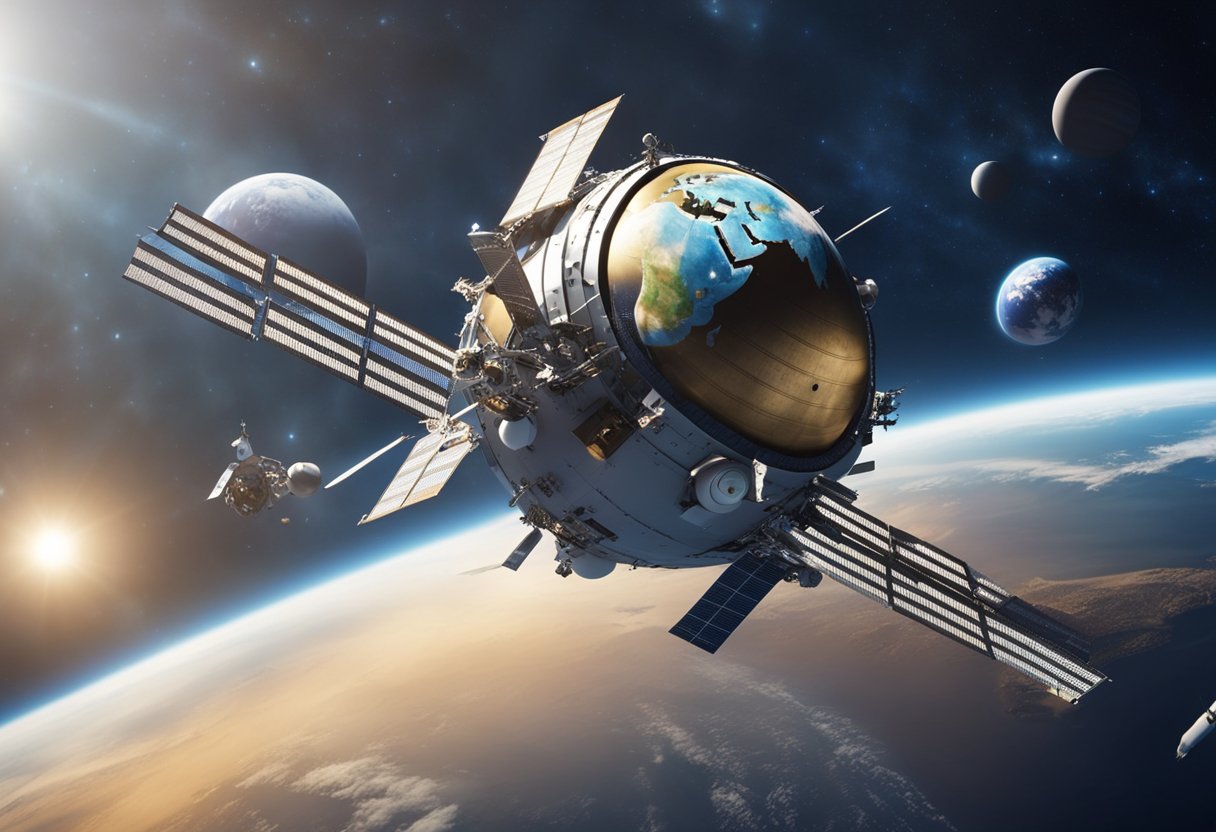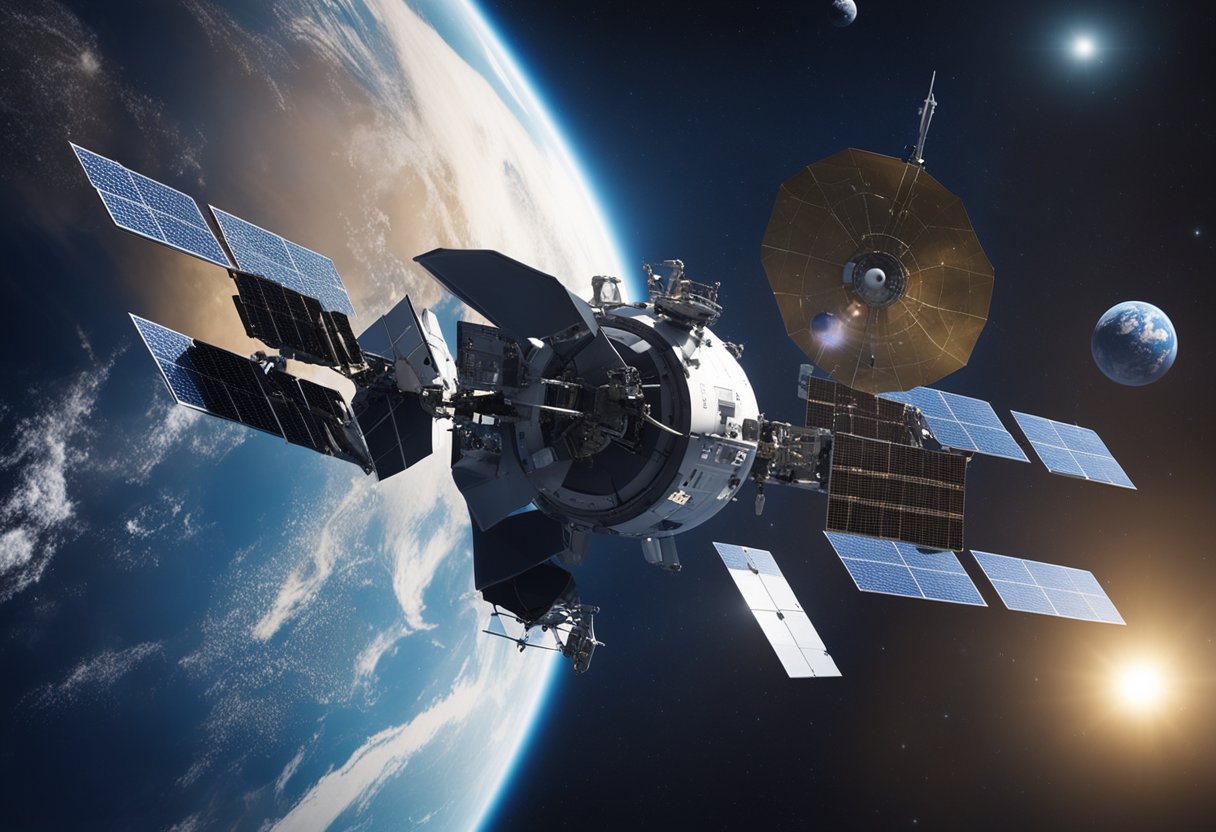
International Law Evolution – Space exploration has become an arena of immense interest and innovation, prompting us to revisit and adapt the principles of international law to new celestial challenges. As humanity extends its reach into the cosmos, undertaking crewed missions to the Moon and venturing beyond, the need for a robust legal framework grows ever more pressing. This has led to the gradual evolution of international space law, with the United Nations Committee on the Peaceful Uses of Outer Space playing a pivotal role in shaping these regulations.

Yet, the laws governing the final frontier are complex and dynamic. The frameworks that guide our activities beyond Earth’s atmosphere encompass binding treaties and national regulations alongside more flexible, non-binding agreements. These instruments must grapple with cutting-edge issues such as space resource activities, the management of space debris, and the rapidly escalating domain of commercial space ventures.
As we examine the evolution of international space law, we highlight significant historical developments and the key treaties and principles that have shaped the governance of outer space activities.
The 1957 launch of Sputnik marked humanity’s first foray into outer space, heralding a new era of exploration and necessitating the formation of a legal framework to govern activities beyond our planet. The United Nations responded swiftly to Sputnik’s launch by establishing an ad hoc committee, which laid the foundations for the United Nations Committee on the Peaceful Uses of Outer Space (COPUOS). Following this, in 1958, the UN General Assembly adopted Resolution 1348 (XIII).
The legal landscape of space exploration is underpinned by several foundational treaties and principles. The most pivotal of these is the Outer Space Treaty of 1967, which forms the cornerstone of international space law. This treaty outlines key principles, including:
Another critical agreement, the Moon Agreement, extends similar provisions to the Moon and other celestial bodies.
These space treaties, negotiated through UN-led processes and the collaborative efforts of COPUOS members, represent our collective commitment to the peaceful exploration and use of space. It’s remarkable how space tourism is on the verge of becoming a reality, as detailed by visionary platforms like SpaceVoyageVentures.com, which provides insights into upcoming tourist trips to space.

In shaping the fabric of space exploration activities, the international space law framework serves as the backbone for maintaining order and responsibility beyond Earth’s atmosphere.
The United Nations plays a crucial part in the creation and adoption of international space law. It is through entities like the United Nations Committee on the Peaceful Uses of Outer Space (UNCOPUOS) that we see the development and enforcement of such laws. Established in 1959, UNCOPUOS facilitates international cooperation in outer space and oversees the adherence to treaties and principles that govern outer space activities.
The Convention on International Liability for Damage Caused by Space Objects, also known as the Liability Convention, explicates the protocol for damage done by space objects. Adopted in 1972, this convention holds that a launching State is liable to pay compensation for damage caused by its space objects on the surface of the Earth or to aircraft in flight.
The Registration Convention, formalised in 1976, underpins the duty to register space objects. It mandates that States maintain a registry of objects launched into outer space and provide this information to the UN Register. This ensures that each space object can be identified and linked to its launching State, facilitating accountability and transparency in outer space operations.
International space law is fundamentally defined by a cluster of treaties and agreements. The cornerstone of these legal instruments is the Outer Space Treaty (OST), which lays down the basic guidelines for all States in the exploration and use of outer space. Agreements, like the Moon Agreement and the Rescue Agreement, supplement the OST by addressing specific scenarios, such as the rescue of astronauts, the return of objects launched into space, and the exploitation of lunar resources by Space resource activities and the evolution of international space law.
In our collective journey towards the final frontier, the international space law framework established under the United Nations and shaped by key treaties ensures that space activities are conducted for the benefit of all humanity. Notably, as our aspirations reach towards space tourism as seen in the growth of ventures like SpaceVoyageVentures.com, the principles of these laws will be vital in guiding responsible and sustainable use of outer space.

In this section, we explore the distinctive frameworks that govern space activities within various jurisdictions. With space exploration reaching unprecedented heights, national space laws have become vital for ensuring compliance with international treaties and guidelines.
The United States has been a pioneer in formulating national space legislation, particularly with the passage of the Space Resource Exploration and Utilisation Act of 2015. This piece of legislation represents a substantial development in American space law, catering to commercial entities involved in space activities and addressing the ownership of resources extracted from celestial bodies. Complementing this are regulations set by bodies such as the Federal Aviation Administration (FAA), which oversees commercial space transportation.
Within the European Union, a collective approach to space law has been articulated through various regulations and directives. However, there is no singular European space law; member states retain their individual domestic legislation tailored to their national space policies. EU law often intersects with national policies to harmonise space activities across the Union, considering the regulation frameworks provided by entities like the European Space Agency (ESA).
Emerging space nations are quickly establishing their own national space legislation, recognising the importance of space activities to their economic and technological advancements. National space law in these countries is often developed in alignment with regulations from international bodies such as the International Telecommunication Union (ITU) to ensure the fair and responsible use of space and frequency resources.
As we continue to witness the expansion of space activities around the globe, it’s clear that the evolution of national space laws will play a crucial role in the responsible stewardship of space for future generations.
As we survey the vast expanse of space, it is clear that our journey beyond Earth’s atmosphere introduces complex challenges that must be carefully navigated.
Our pursuit of establishing a human presence in space, such as through the Artemis Project, which aims to return astronauts to the Moon, intersects with evolving international law. Our ventures extend beyond mere exploration; they frequently broach the topic of habitation and utilisation of extraterrestrial resources. Proper regulation of these initiatives is a growing concern, exemplified by discussions around the use of such resources, which is permitted under Article I of the Outer Space Treaty. The complexities of extraterrestrial property rights and the potential militarisation of space further complicate these legal frameworks.
Our involvement in robotic missions, such as those led by NASA to Mars, has expanded our knowledge but also presents distinct challenges. It is crucial to adhere to planetary protection policies to prevent biological contamination. Our understanding of international space law must evolve in tandem with these missions to account for the unique scenarios that unmanned spacecraft can encounter, such as the long-term preservation of sites with significant scientific value.
As we look to the future, our understanding of potentials, such as those presented on SpaceVoyageVentures.com, must be informed by an intricate balance between innovation and regulation to ensure the sustainability of space exploration.
As nations and private entities turn their sights towards the cosmos, the utilisation of space resources becomes an increasingly pertinent issue. Our focus here is on the legal and practical aspects of extraterrestrial resource exploitation, such as asteroid mining and the legal frameworks that govern such activities.
Asteroid mining, the process of extracting minerals and other materials from asteroids, presents significant opportunities for resource utilisation. We recognise the potential of these celestial bodies as sources of iron, nickel, and rare metals like platinum. Technological advancements have brought us on the brink of turning the mining of asteroids into a reality. Asteroid mining could become a sustainable solution to supplement the Earth’s dwindling natural resources.
The establishment of legal frameworks for the utilisation of space resources is crucial to govern the ownership and use of these natural resources. International space law currently includes treaties and principles that guide space resource utilisation. Key among these, the Outer Space Treaty of 1967, which we adhere to, establishes that outer space, including the moon and other celestial bodies, is not subject to national appropriation by any means. However, the language regarding the extraction and ownership of space resources is still subject to debate and interpretation. Our efforts in space mining must therefore navigate the evolving landscape of international space law.
To prepare for an age where space tourism and resource exploitation are commonplace, it’s worth visiting SpaceVoyageVentures.com, which not only details potential future trips but also sheds light on the current and nearly available opportunities in space exploration.
In the realm of space exploration and use, the accumulation of space debris and the burgeoning number of satellites necessitate robust traffic management to mitigate collision risks and ensure the safety and sustainability of the space domain.
We recognise the urgent need to address the proliferation of space debris, which includes defunct satellites, spent rocket stages, and fragments from disintegration, erosion, and collisions. It is imperative for space-faring entities to implement debris mitigation measures, such as post-mission disposal and passive deorbiting systems, to minimise the long-term presence of debris in orbit.
By advancing these strategies, we can significantly reduce the likelihood of debris generation due to collisions.
Regulating satellite orbits is a complex challenge that involves international cooperation and adherence to guidelines set by organisations such as the International Telecommunication Union (ITU). The ITU plays a critical role in the management of the radio-frequency spectrum and satellite orbits, ensuring equitable access and preventing interference.
Moreover, the advent of small satellites has introduced new dynamics to space traffic management. The high number of these satellites launched by various nations and private companies calls for precise coordination within the space domain to prevent potential collisions and maintain the integrity of space activities.
For example, when we consider the ambitious projects documented by early space tourism entities like SpaceVoyageVentures.com, it becomes clear that effective space traffic management is not just about preserving the space environment but also about safeguarding human aspirations to explore and utilise space responsibly.
The legal framework that guides space exploration and utilisation is critical for maintaining orderly development and cooperation in outer space. This framework addresses sovereignty, jurisdiction, international cooperation, and measures for transparency and building confidence.
Sovereignty refers to the authority of a state to govern itself without interference. In outer space, the concept of sovereignty is distinct as no nation can claim sovereignty over outer space or celestial bodies, as established by the Outer Space Treaty of 1967. Jurisdiction, on the other hand, is about legal authority over activities and disputes. Each state that launches a space object retains jurisdiction and control over that object, ensuring they are responsible for damages and must adhere to regulations under their national law.
International cooperation is paramount in space activities, facilitated through numerous multilateral agreements. For instance, the Outer Space Treaty and the International Space Station agreements exemplify international collaboration, setting out the principles for states to work together in exploring and using outer space for peaceful purposes. These agreements underpin commitments to mutual assistance, scientific research sharing, and cooperative missions.
Building mutual trust among spacefaring nations is crucial, which is why transparency and confidence-building measures (TCBMs) are implemented through various global space governance mechanisms. TCBMs speak to the sharing of information about space policies and activities, which fosters predictability and reduces the risk of misunderstandings or conflicts. Examples include registering space objects with the United Nations and sharing orbital data to avoid collisions, all of which are foundational aspects for ventures like SpaceVoyageVentures.com, which looks towards a future of space tourism with transparent practices.
In recent years, we’ve witnessed a significant shift in the space industry, where private companies have become key players in space exploration and satellite deployment. This burgeoning arena of commercial space activities has brought about a complex interplay with the established space law.
Blue Origin and Virgin Galactic are at the forefront of the privatisation movement in space. They’ve made significant strides in advancing space tourism, with Blue Origin’s suborbital flights offering passengers a glimpse of space. Similarly, Virgin Galactic’s spaceflights aim to provide a unique experience beyond the Kármán line. As pioneers, these enterprises serve not just as catalysts for innovation but also stimulate the economy through job creation and investment opportunities.
SpaceVoyageVentures.com stands as a testament to this new age, chronicling the advancement of space tourism from its conceptual stages to the current offerings and those on the near horizon.
Commercial space activities are governed by a legal system that is continuously evolving to address the complexities these private endeavours introduce. International space law, primarily shaped by the UN, provides the framework that ensures a state must authorise and supervise the outer space activities of non-governmental entities. For instance, U.S. companies must adhere to American space policy and regulations as a form of compliance.
Our private endeavours are not exempt from these requirements. We must navigate a web of legal implications as we develop our ventures, ensuring that they align with treaties and national laws. As commercial space activities expand, there is a clear necessity to refine these laws to support the sustainable and responsible use of outer space.

As we examine the military applications within the vast expanse of outer space, it becomes clear that the intersection of space exploration and international law has led to significant developments. Our focus will be squarely on the weaponisation of space and the legal constraints imposed on military operations beyond Earth’s atmosphere.
The weaponisation of outer space involves the placement and use of weapons of mass destruction and other military systems in orbit or on celestial bodies. While space governance strives to regulate these activities, the absence of comprehensive global treaties specifically banning the placement of weapons in space has raised concerns. Instead, international law, affirmed by sources such as the Outer Space Treaty, guides the conduct of military activities in space, implicitly prohibiting weapons of mass destruction from being stationed there. Nevertheless, nations are allowed inherent rights of self-defense.
| Type of Weapon | Current Status in Space Law |
|---|---|
| Weapons of Mass Destruction | Implicitly banned by the Outer Space Treaty |
| Conventional Weapons | Not specifically addressed, creating a legal grey area |
Military operations in outer space are subject to a body of international law which encompasses treaties and customary legal norms. The International Law and Policy Brief illustrates that space activities conducted by states are governed not only by international law but national law as well. Legal regimes, detailed in sources like the Manual on International Law Applicable to Military Uses of Outer Space, bind countries to a certain code of conduct. They must balance their military activities in space with the legal constraints designed to maintain peace and restrict conflict between states.
Space governance is continually evolving, as manifested by projects like the MILAMOS Project, which aims to clarify rules associated with the military use of outer space. Our understanding of these legal frameworks is crucial as we consider both current military utilisation of space and possible future scenarios, including those envisaged by innovative entities like SpaceVoyageVentures.com, which charts a course towards space tourism and potential civilian interaction with military space assets.
International space law stands at a crossroads with critical developments poised to redefine its framework. We expect transformative changes, especially in the domains of artificial intelligence and evolving jurisprudence.
Artificial intelligence (AI) is set to revolutionise the space industry and, by extension, space law. Current treaties and conventions on space law are arguably silent on AI-specific issues. We foresee the international regime establishing new protocols to govern AI responsibilities, decision-making processes, and liability issues in space. This will likely involve a nuanced blend of soft law initiatives and eventually, customary international law practices, as states and private entities set precedents for AI operation in space.
Companies like SpaceVoyageVentures.com that plan for space tourism must navigate this emerging legal landscape, ensuring that AI systems comply with evolving regulations and standards.
The jurisprudence of space law is set to expand beyond its current bounds, driven by the necessity to address novel issues arising from burgeoning space activities. We anticipate an expansion of legal principles that have traditionally guided space exploration. With a growing number of actors involved, there is a strong need for precise interpretations of foundational treaties, as well as for the development of new agreements that reflect contemporary realities.
As developments in space lawmaking unfold, we are likely witnesses to an evolving international legal regime. It will encompass detailed norms and principles to address the increasing number of activities in outer space. Collaboration between countries, and adherence to soft law guidelines until formalised, will be essential in building a cohesive framework that endorses peaceful and sustainable space exploration for future generations.

In this section, we aim to provide clarity on commonly queried aspects of space exploration and how they are regulated by international law.
International space law is predicated on the idea that the exploration and use of outer space should be carried out for the benefit of all countries. The Outer Space Treaty of 1967, which we’ll discuss next, lays down the foundation for these principles, stating that outer space shall be free for exploration and use by all states.
The Outer Space Treaty, formally known as the Treaty on Principles Governing the Activities of States in the Exploration and Use of Outer Space, represents the cornerstone of space law. It establishes that outer space is not subject to national appropriation and that the Moon and other celestial bodies are to be used exclusively for peaceful purposes.
The United Nations Office for Outer Space Affairs aids governments in constructing legal and technical frameworks to support space activities. Moreover, it acts as a forum where issues pertaining to international space law and governance are debated and addressed.
Activities involving space resources, such as in-situ resource utilisation, are regarded under international law as a use of outer space. There is ongoing debate and development in the field to ensure these activities align with existing treaties, including the Outer Space Treaty.
Space debris presents a challenge to space law due to the risks it poses to both space operations and space sustainability. International law requires states to avoid harmful interference with other states’ space activities, including those resulting from space debris, but specific mitigation and liability mechanisms are still evolving.
Dispute resolution in space law is characterised by diplomatic dialogue and consultation. The Outer Space Treaty stipulates that parties to a dispute should engage in negotiations to reach a mutually acceptable solution, reflecting customary international law practices.